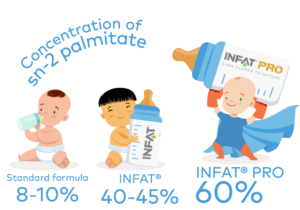Another step towards the gold standard
INFAT®PRO – The right type of fat where it matters most
Human milk offers the best possible nutrition for infants and represents the gold standard for the infant nutrition industry.
Since the first attempt to provide infants with a ‘breast milk substitute’ in the 1800s, physicians, scientists and those working in the infant formula industry have been working to better understand human milk.1
Researchers have looked at human milk’s bioactive components and how they can benefit the infant’s healthy development in an ongoing effort to provide the best possible alternative for those who are unable to breastfeed.
The years of research have shown that the quantity and quality of the lipids in formula has a significant impact on health outcomes.2 Among other essential functions, fat provides as much as 50% of the energy needed for infants’ growth.3
The fat in modern infant formula is often made with a blend of vegetable oils, aiming to mimic the fatty acid composition of human milk. However, replicating the structure of human milk’s fatty acids is not easy – particularly so in the case of palmitic acid, which is the most common saturated fatty acid found in human milk.4
Studies have shown that palmitic acid is well absorbed when it is located in the centre of the fat molecules’ glycerol backbone, a position known as ‘sn2’.5 In breastmilk, around 70-80% of the palmitic acid is located in the sn2 position. Palmitic acid in the sn1 and sn3 positions, on the other hand, has been found to increase the formation of calcium soaps, which may contribute to stool hardening.6
Palmitic acid in the central position is known as sn2 palmitate, or OPO in China. In the vegetable oils commonly used in infant formulas, the concentration of sn2 palmitate is only about 8-10%, but Advanced Lipids’ INFAT® features around 40-45% sn2 palmitate.

Compared to infant formulas containing the standard vegetable oil blend, formula that is high in sn2 palmitate has been clinically tested to increase fat and calcium absorption, improve bone matrix quality, improve stool consistency, and have a positive effect on the development of healthy gut bacteria. It has also been shown to improve babies’ wellbeing.
INFAT®, a high sn2 palmitate specialty oil, has now been on the market for more than a decade, consumed by hundreds of millions of infants in many countries around the globe, and has proved especially popular in China.
Now, Advanced Lipids has taken another step forward with the launch of INFAT®PRO. While the standard INFAT® enabled manufacturers to create formula with 40% of the palmitic acid in the central position, INFAT®PRO allows the formula producers to have sn2 palmitate levels of approximately 60%.

Many studies show there are a wide variety of benefits to be gained from high concentrations of sn2 palmitate in infant formula.7While breastmilk still represents the gold standard, INFAT®PRO comes closer than ever before to its special structure.
1 Stevens, E.E. ‘A History of Infant Feeding’ The Journal of Perinatal Education (2009)
2 Mazzocchi, A. et al. ‘The Role of Lipids in Human Milk and Infant Formulae’ Nutrients (2018)
3 Manson, W. G. & Weaver, L. T. ‘Fat digestion in the neonate’ Archives of Disease in Childhood Fetal and Neonatal Edition (1997)
4 Jensen, R.G., Hagerty, M.M. & McMahon, K.E. ‘Lipids of human milk and infant formulas: a review’ The American Journal of Clinical Nutrition (1978)
5 Miles, E.A. & Calder P.C. ‘The influence of the position of palmitate in infant formula triacylglycerols on health outcomes’ Nutrition Research (2017)
6 Havlicekova, Z. et al ‘Beta-palmitate – a natural component of human milk in supplemental milk formulas’ Nutrition Journal (2016)
7 Miles, E.A. & Calder P.C.


